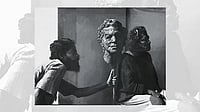Bellary-born dancer Saroja Vaidyanathan was initially trained in Bharatnatyam at Saraswati Gana Nilayam in Chennai and later studied Carnatic music under Guru P Sambamoorthy at the Madras University. Saroja ji, as she is called, had a D. Litt in dance from Indira Sangeet Vishwavidyalaya, Khairagarh. She was conferred the Padma Shri in 2002 and Padma Bhushan in 2013. Many other honours have come her way.
Saroja ji, a dancer of international repute, a teacher and a choreographer, was married off while in her teens and gave up dancing after marriage following negative reactions to her doing public performances. Perforce she started teaching dance to children at home. Her husband was posted to Delhi in 1972, and she went through a lot of hardship to establish Ganesa Natyalaya there in 1974.
Ups and downs were a part and parcel of her life but she was made of sterner stuff and came out unscathed. Her daughter-in-law, Rama, is a well-known dancer and Rama’s daughter Dakshina is following suit and is getting widespread recognition.
Saroja ji’s story in her own words
I have been dancing since childhood, from the age of seven or so. At 16, I performed for the first time. A film producer called Mr Madhavan came to my house and said I danced very well and was good-looking. “I want to take her in my film,” he said. That was the end for me!
My family was very orthodox and everyone was very talented. There were bureaucrats who thought that the family name would be ruined if I danced in films. In those days, cinema was not seen with respect.
There was a big conference. My paternal and maternal sides met and got me married to an IAS officer in 1954. I was sixteen and a half. I wasn’t even asked. I wanted to study and dance. I was learning Veena and Carnatic Music, and flute. I was a child prodigy. They said: “Nothing doing. This is bad for the family.”
I got married and thought everything was over. But then my guru, Lalitamma, and her guru, Katmanna Muthukumaran Pillai, a very famous guru of Thanjavur, taught me for 10 years. Both recorded compositions and gave them to their disciples. It was unimaginable in those days that a guru would record her compositions and also distribute them. She gave them to me to practice which I used to do for one to two hours a day.
Kept a low profile to avoid any scandals
Being a Collector's and later Commissioner’s wife, I started performing and teaching. I kept a very, very low profile since my husband felt my work should not become widely known, or else there would be a scandal! I agreed. I performed at the Lion’s and Rotary Clubs for free. I charged very little from my students — 5-10 rupees. That was the fee. I didn’t mind! I had a huge house and had a full wing for dancers. I played my gurus’ LPs. I was the president of many clubs and led an active life.
When my husband was the Bhagalpur Commissioner, a Kathak School called Sangeet Sadan approached me and said: “You are the Commissioner’s wife and an artiste. We don't have the money to build a structure.” For them, I arranged a three-day music conference. Bismillah Khan, Kishan Maharaj, Sitara Devi, and Roshan Kumari came. I paid very little. I told them the collection here is going to the Kathak Centre. Everybody was paid Rs 10,000, but they agreed to give back Rs 5,000. It was a great thing to have funds returned to us by them. This was in 1972.
With great difficulty, I collected about Rs 2 lakhs and made a building with one room, a big hall, a bathroom, a toilet and all the facilities for a school for Sangeet Sadan.
My name is still there as Saroja Bhavan! This way, I kept myself very active. I would invite youngsters for Holi, Diwali, and Dussehra festivals. I even did shows on Cinderella, and Snow White and took music from Pt Ravi Shankar, among others, for choreographers. I kept letters, cards and a few photographs from the Sangeet Sadan times. Something told me to preserve all this.
In 1972 my husband came back to Delhi and I never looked back. I kept rising.
‘Never lost confidence in my dance’
I never lost confidence in my dance. I was strong but had to sacrifice many things. My husband said my dancing posed no problems for him professionally but he should not get a bad name as he was an honest IAS Officer. I asked him what he wanted. He said he would select the places where I would dance. Nowadays everyone dances in hotels. Then nobody did. All official meetings were in the ministry. He told me not to dance in hotels as he would get a bad name, or in any of the ministries as people would think he had got me the assignment. He never wanted money accepted from students. I said that can’t be done because the institution had to grow and not me.
I decided I would collect money and that my students should pay as otherwise they would not respect my teaching or bother about it. In 1974, I got more serious about collecting funds. We started in a small way with just four students in Curzon Road (now called KG Marg). Other personal matters may have affected me deeply but I never let those affect me. I had a family and felt they should not be disturbed. I wanted both family and professional life at the same time.
Good atmosphere for dancing
There was an atmosphere for dance in those days. I learnt dancing till I was 15. Music masters would come home and teach. The atmosphere for that too was good. Life then was a very simple affair. I learnt the veena also. One day, my mother asked me how many things I was going to learn considering I was going to get married. Her thinking was very orthodox that way.
My father was in the Royal Air Force. He worked with the British in the UK for seven years. When he returned, my mother was a school principal. She wrote detective stories and published some 20 books. She also painted very well and had modern thinking, too. Both felt that Indian heritage should not be disturbed or family life should not be scattered. They felt that I would leave home if I became a dancer, but allowed me to learn dance at school.
I studied at the Stella Maris College in Chennai. Father too was keen that I study and forget dance. In those days, family bonds were very strong. Nowadays, people don’t know who is their first cousin! We feared stepping out of line then alone.
Starting a dance school (Ganesa Natyalaya) was very difficult as we had no funds. Mr Jagmohan was the Lt Governor and I thought of approaching him. My husband was aghast at the idea of a school and a building, saying that the family had to go back home to South India. I told him that he should let me do it till I was in Delhi. I went to Jagmohan, who said: “Let Saroja buy the land. Let her do what she wants to do.”
Jewels fetched Rs 2 lakhs
Jagmohan was a friend of my husband’s. I took a loan of Rs 10 lakhs and I also took Rs 2 lakhs from my husband from his Provident Fund. The Department of Culture gave Rs 7 lakhs. My jewels fetched Rs 2 lakhs. I paid back in several years, but I did pay back.
We had a labour contractor, but not an engineering contractor. The foundation stone was laid by the then Lt Governor Jagmohan. Later, President Dr Shankar Dayal Sharma inaugurated the centre. My book on Bharatnatyam was released by Indira Gandhi in 1985. I named it The Science of Bharat Natyam and printed 2,000 copies on behalf of Ganesa Natyalaya. I got maddening reviews because Indira Gandhi said it was a very good abhyas for health, particularly for politicians! This comment came out in the newspapers will hilarious illustrations of politicians exercising, dancing! I have all those press clips!
I inherited my strength from my mother, who was alone for seven years while my father was in UK in the RAF. When he came back, he got many offers, but he said no saying that he had seen much pain and wanted to be with his family.
Mingling was not encouraged in those days
During my younger days, there was no mixing or touching or you were finished! Those days appear so funny now. Today's generation is completely different — it is so open. I like this as they don’t play hide and seek. If we wanted to see a film, we would say that we were going to a friend’s house. If caught, we were told angrily we were ruining our lives and asked if we had nothing better to do. There would be a great deal of anger. Life was like that then.
This wasn’t frustrating at all. Today, at dinner, everything is in front of the kids. Children take part and share opinions. Today, I can discuss everything in front of my students, but couldn’t 60 years back with my gurus. One couldn’t open one’s mouth when elders would talk, and if one did, one stern look would follow and one had to leave the room!
(As told to Atul Mital)
























